
Brno in Prague - Kuba Pilař Architects
The end of last week was marked by a regained trust in architectural competitions. Initially, it did not seem that way at all. On Thursday afternoon, a more than three-hour debate took place at the National Gallery dedicated to the media-friendly topic of the winning project for the National Library in Letná. The main moderator, Milan Knížák, aimed for a sharp discussion free of invective. With varying degrees of success, he managed to maintain a non-hysterical atmosphere. After familiarizing attendees with the formal and substantive shortcomings of Kaplický's project, the debate shifted to what legal steps can currently be taken to question the legitimacy of the competition. Participants could improve their mood from the darkened hall on the sunlit terrace of the NG soaring high above the gable roofs of the surrounding apartment buildings.
Before the concluding lecture of the spring series of the Circle dedicated to Moravian architects, Pavel Nasadil managed to tarnish the perception of architectural competitions in our country even further. Although his team won the competition for the new design of two faculties in Brno half a year ago, it is still unclear how the construction will be financed and whether they will actually be awarded the contract. After the organization of the competition and the payment of substantial financial rewards, the absence of a longer-term vision and the lack of coordination among various parts of the VUT are starting to become apparent.
Into this atmosphere stepped the duo of architects Ladislav Kuba and Tomáš Pilař, who based their lecture on a retrospective of their competition projects over the past ten years. In addition to giving the audience a comprehensive picture of the studio's work within two hours, the architects themselves could reflect with the passage of time on what significance architectural competitions hold for them and create a retrospective success statistic that awaited us at the very end. Anyone who knows KPA's work even a little knows how high the demands are, ranging from diligent concept searching to impressively rendering an idea on paper and up to an irreconcilable struggle with contractors on the construction site. Their Prague lecture was no exception in this regard. With a quality-prepared presentation visually and a rapid exchange of words between both speakers, the audience was not bored for the entire two hours. I did not count all the presented designs, but if they indeed showed all 25 competition projects that the office designed during its ten-year existence, it would mean less than five minutes per design. It couldn’t be shorter. The individual projects were arranged chronologically according to the competition's organization date. They could not start the introduction in any other way than with the notoriously well-known library of the Faculty of Arts at MU in Brno. The first jointly won competition proposal underwent significant changes due to new client requirements, which ultimately benefitted the project, and its authors rightfully received GP OA 2002. Another significant block was the freshly completed first phase of the residential complex Na Krutci. The unusually prolonged competition had a happy ending for KPA and a promising second phase of construction of family houses. A nicely tangled story with a good ending was also the competition project for the development of the most exposed plot in Brno. Although they managed to win with the best design, the contract came back to them only after the change of the landowner. As it often happens with some investors, their proposal had to undergo a slimming process and cooperate with a less-than-ideal design partner. Besides the generally known winning proposal and its eventual realization, the presentation also showcased developmental intermediary phases of the project. Using the example of the Pardubice Faculty of Chemical Technology, they demonstrated that not all projects can be realized according to their own visions. Most people in the audience also had the chance for the first time to see some invited competition projects that have not yet been published anywhere. For example, their project of construction with the cumbersome name Chapel of Our Lady Mother of European Nations in Znojmo, which was eventually won by another Brno office, featured a simple form with a strong expression lightened by the theme of the stars of the European Union embedded into this sacral building.
The KPA lecture focused exclusively on competitions, and unfortunately, we did not receive any verbal accompaniment or further information on their reconstructions or known realizations of sacral buildings, which, however, was not a disadvantage. They did not dilute such a lengthy lecture with other office activities and directed their joint tandem towards the pre-announced bonus that awaited us at the very end of the lecture. This was several clear tables with statistically expressed success of the studio in competitions. It was hard to believe that they do much better in public competitions with dozens of participants than in invited ones. While winning public competitions is slowly becoming their daily bread, they only managed to break their bad luck in invited competitions last year. In the skeptical atmosphere fueled by discussions on the NK competition topic, the KPA lecture acted as a revitalizing agent. It is not easy to establish and run an office where a significant share consists of contracts won in public competitions. In some cases, it took them years for the winning project to be realized; at other times, they had to defend their position in subsequent unplanned rounds of competition, and they had to experience situations where the winner ultimately did not obtain the contract, or the necessary funds for realization were not found, but nevertheless, it is a path worth following. Ladislav Kuba and Tomáš Pilař presented the best from the Moravian metropolis in the concluding cycle "Brno in Prague" during the muggy Thursday evening at Wilson Station.
Less than 24 hours after the Prague Circle lecture, I met architect Kuba in the "lounge" of Fránek's studio, where Jan Tabor invited Austrian architect Albert Wimmer as the main guest of the evening. Whatever conclusion one might draw after Wimmer’s lecture, it is a reassuring fact that the presented projects (like most of his work) are the result of victories in architectural competitions. Petr Rezek then tried to extract from Albert Wimmer his own recipe for success in competitions for his students from Liberec. Although it is not currently possible to compare both scenes equivalently, as Austria increasingly confronts the Czech Republic, we will see more young studios starting their careers (similarly to Kuba and Pilař) with success in architectural competitions.
Before the concluding lecture of the spring series of the Circle dedicated to Moravian architects, Pavel Nasadil managed to tarnish the perception of architectural competitions in our country even further. Although his team won the competition for the new design of two faculties in Brno half a year ago, it is still unclear how the construction will be financed and whether they will actually be awarded the contract. After the organization of the competition and the payment of substantial financial rewards, the absence of a longer-term vision and the lack of coordination among various parts of the VUT are starting to become apparent.
Into this atmosphere stepped the duo of architects Ladislav Kuba and Tomáš Pilař, who based their lecture on a retrospective of their competition projects over the past ten years. In addition to giving the audience a comprehensive picture of the studio's work within two hours, the architects themselves could reflect with the passage of time on what significance architectural competitions hold for them and create a retrospective success statistic that awaited us at the very end. Anyone who knows KPA's work even a little knows how high the demands are, ranging from diligent concept searching to impressively rendering an idea on paper and up to an irreconcilable struggle with contractors on the construction site. Their Prague lecture was no exception in this regard. With a quality-prepared presentation visually and a rapid exchange of words between both speakers, the audience was not bored for the entire two hours. I did not count all the presented designs, but if they indeed showed all 25 competition projects that the office designed during its ten-year existence, it would mean less than five minutes per design. It couldn’t be shorter. The individual projects were arranged chronologically according to the competition's organization date. They could not start the introduction in any other way than with the notoriously well-known library of the Faculty of Arts at MU in Brno. The first jointly won competition proposal underwent significant changes due to new client requirements, which ultimately benefitted the project, and its authors rightfully received GP OA 2002. Another significant block was the freshly completed first phase of the residential complex Na Krutci. The unusually prolonged competition had a happy ending for KPA and a promising second phase of construction of family houses. A nicely tangled story with a good ending was also the competition project for the development of the most exposed plot in Brno. Although they managed to win with the best design, the contract came back to them only after the change of the landowner. As it often happens with some investors, their proposal had to undergo a slimming process and cooperate with a less-than-ideal design partner. Besides the generally known winning proposal and its eventual realization, the presentation also showcased developmental intermediary phases of the project. Using the example of the Pardubice Faculty of Chemical Technology, they demonstrated that not all projects can be realized according to their own visions. Most people in the audience also had the chance for the first time to see some invited competition projects that have not yet been published anywhere. For example, their project of construction with the cumbersome name Chapel of Our Lady Mother of European Nations in Znojmo, which was eventually won by another Brno office, featured a simple form with a strong expression lightened by the theme of the stars of the European Union embedded into this sacral building.
The KPA lecture focused exclusively on competitions, and unfortunately, we did not receive any verbal accompaniment or further information on their reconstructions or known realizations of sacral buildings, which, however, was not a disadvantage. They did not dilute such a lengthy lecture with other office activities and directed their joint tandem towards the pre-announced bonus that awaited us at the very end of the lecture. This was several clear tables with statistically expressed success of the studio in competitions. It was hard to believe that they do much better in public competitions with dozens of participants than in invited ones. While winning public competitions is slowly becoming their daily bread, they only managed to break their bad luck in invited competitions last year. In the skeptical atmosphere fueled by discussions on the NK competition topic, the KPA lecture acted as a revitalizing agent. It is not easy to establish and run an office where a significant share consists of contracts won in public competitions. In some cases, it took them years for the winning project to be realized; at other times, they had to defend their position in subsequent unplanned rounds of competition, and they had to experience situations where the winner ultimately did not obtain the contract, or the necessary funds for realization were not found, but nevertheless, it is a path worth following. Ladislav Kuba and Tomáš Pilař presented the best from the Moravian metropolis in the concluding cycle "Brno in Prague" during the muggy Thursday evening at Wilson Station.
Less than 24 hours after the Prague Circle lecture, I met architect Kuba in the "lounge" of Fránek's studio, where Jan Tabor invited Austrian architect Albert Wimmer as the main guest of the evening. Whatever conclusion one might draw after Wimmer’s lecture, it is a reassuring fact that the presented projects (like most of his work) are the result of victories in architectural competitions. Petr Rezek then tried to extract from Albert Wimmer his own recipe for success in competitions for his students from Liberec. Although it is not currently possible to compare both scenes equivalently, as Austria increasingly confronts the Czech Republic, we will see more young studios starting their careers (similarly to Kuba and Pilař) with success in architectural competitions.
The English translation is powered by AI tool. Switch to Czech to view the original text source.
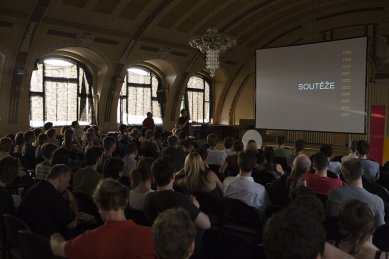
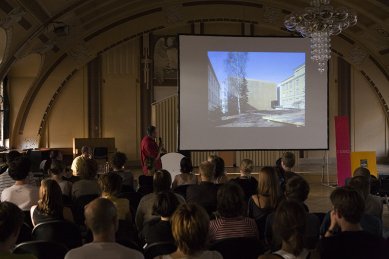
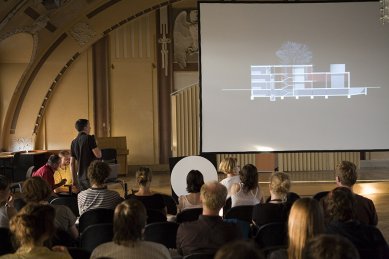
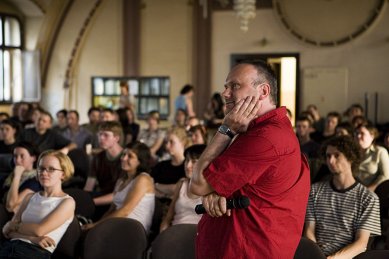
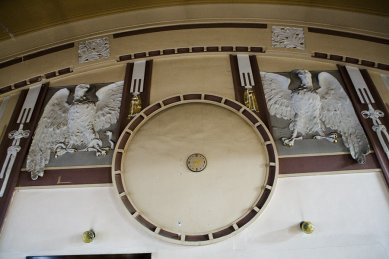
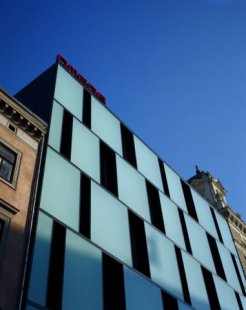
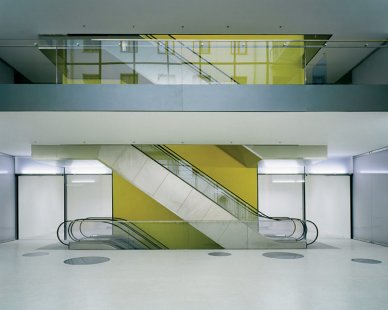
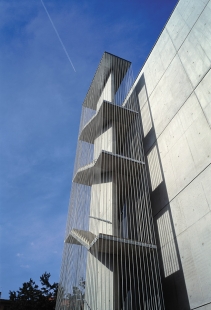
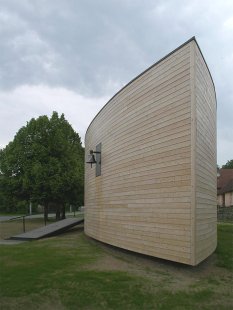
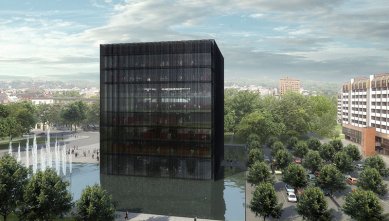
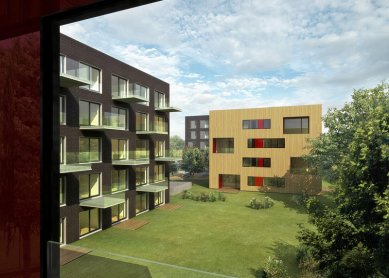
1 comment
add comment
Subject
Author
Date
Jeden hot a druhý čehý
u_saturna
08.07.07 03:33
show all comments










